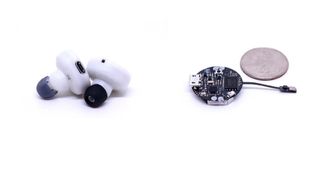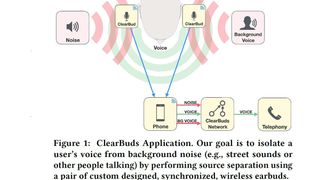AirPods could get a lot better thanks to Nvidia GPUs
Another step forward for Nvidia’s campaign to prove the value of AI

A small group of computer science and engineering students at the University of Washington have designed a new set of wireless earbuds that use AI-powered technology to provide a better standard of background noise cancellation during phone calls.
The earbuds - which the students have dubbed ClearBuds, an excellent name in our opinion - work by monitoring two separate audio streams from the microphones on the left and right buds to create a spatial audio soundscape, then sending the data to a phone which runs a pair of neural networks to clean up background sounds.
The first neural network suppresses any sound that isn’t the caller’s voice, while the second amplifies and improves the clarity of that voice. The result is a significant improvement in the removal of background noise, which the students found to be 6.94 dB better than the noise cancellation of the Apple AirPods Pro.

Both neural networks were trained over the course of one day by utilizing the AI deep learning capabilities of Nvidia’s Titan desktop GPUs. Nvidia has been keen to emphasize the potential of AI for improving gaming via DLSS, but also how we use technology in all areas of life, recently setting up a new program for businesses to begin implementing AI tech at the enterprise level. AMD is even getting involved, despite previous comments to the contrary.
Analysis: Awesome tech that will need an industry shift to become useful

At this point, the majority of wireless earbuds implement some level of active noise cancellation (ANC), which works but monitoring external sounds via a microphone and creating an inverted sound wave signature to cancel them out. Some are pretty good, but this new technology could lead to a leap forward in ANC performance.
There are a few kinks that need to be ironed out first though - and they’re not problems with the ClearBuds (again, great name) themselves. The first is that the neural network requires spatial audio to work correctly, which means that the user must wear both earbuds for full functionality - and we won’t be the only ones guilty of slapping in a single bud when out and about.
A more pertinent issue identified by the UoW students in their post-project analysis is the fact that consumer earbuds currently use ANC by monitoring audio from a single earbud, despite most featuring a microphone in both buds (because of the propensity of users to wear just one).
Get daily insight, inspiration and deals in your inbox
Get the hottest deals available in your inbox plus news, reviews, opinion, analysis and more from the TechRadar team.
This means that manufacturers would have to amend how their devices work in order to implement this AI-based ANC, and the tech could also result in decreased battery life for both the earbuds and the connected phone, which powers the actual neural network process. Personally, we hope these students can find a business partner - with a name that good, ClearBuds sound like the next big hit.

Christian is TechRadar’s UK-based Computing Editor. He came to us from Maximum PC magazine, where he fell in love with computer hardware and building PCs. He was a regular fixture amongst our freelance review team before making the jump to TechRadar, and can usually be found drooling over the latest high-end graphics card or gaming laptop before looking at his bank account balance and crying.
Christian is a keen campaigner for LGBTQ+ rights and the owner of a charming rescue dog named Lucy, having adopted her after he beat cancer in 2021. She keeps him fit and healthy through a combination of face-licking and long walks, and only occasionally barks at him to demand treats when he’s trying to work from home.
